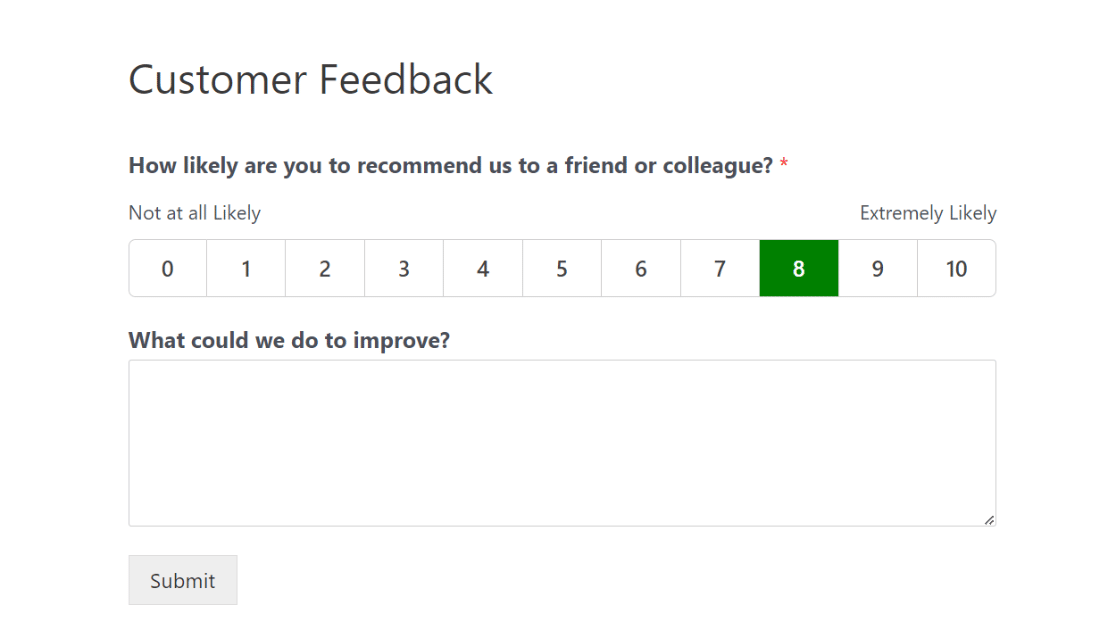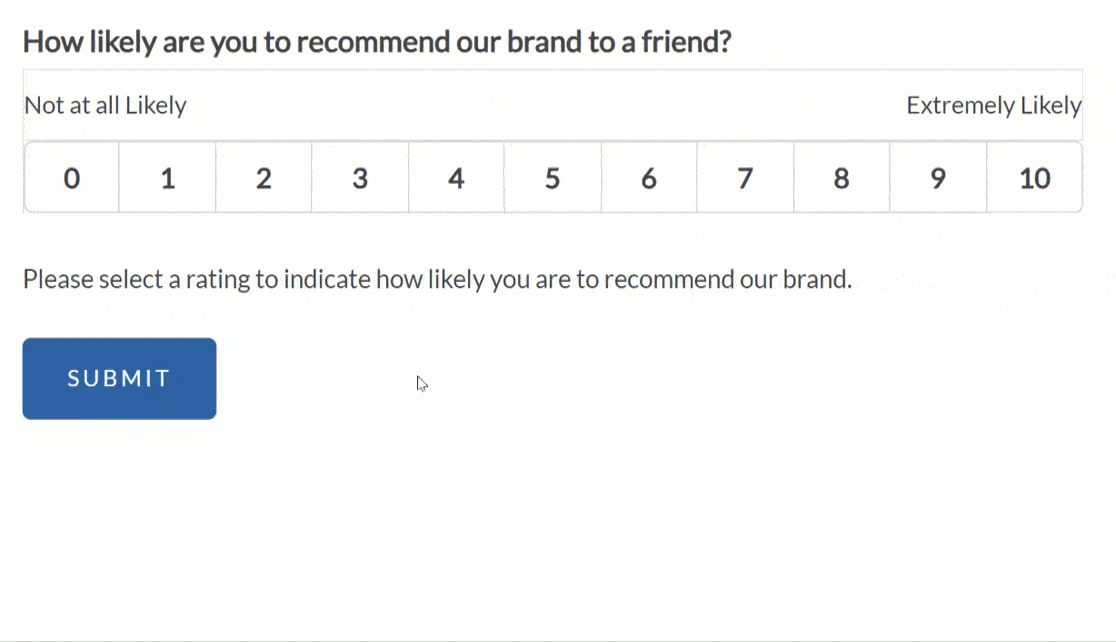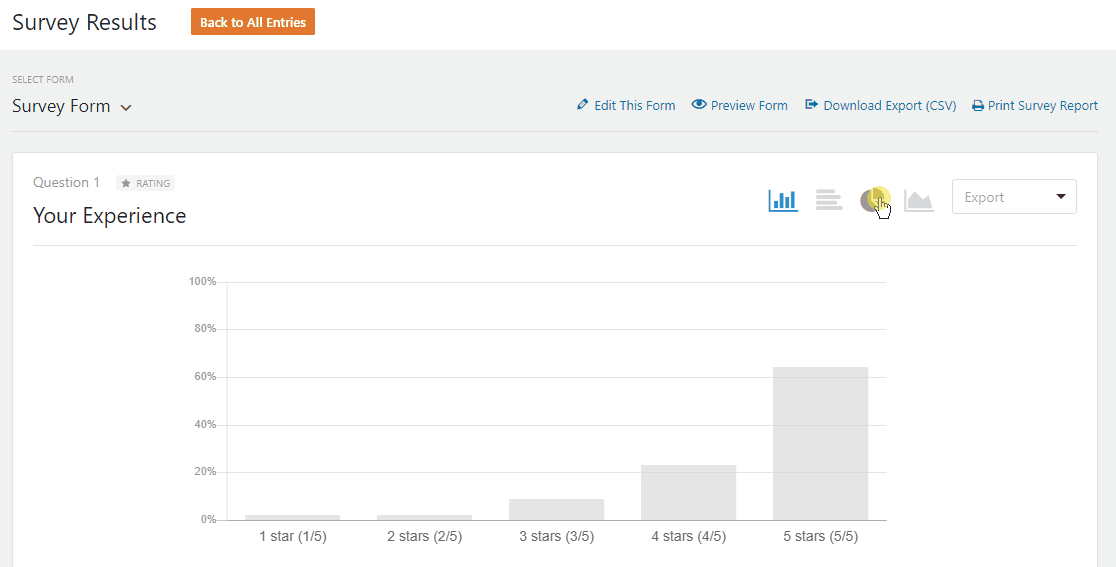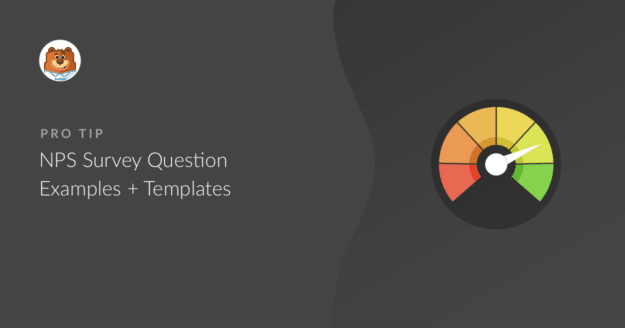Adding an NPS survey to your website? Net Promoter Score surveys are a fantastic way to use customer ratings to see how if your business is meeting their expectations.
In this post, I’ve listed some great NPS Survey question examples and templates.
Create Your NPS Survey Form Now
In This Article
- 1. What is the primary reason for your score?
- 2. What motivates you to recommend us to others?
- 3. What could we do to improve your experience?
- 4. Which features do you use the most?
- 5. What do you like the most about our company?
- 6. What do you like the least about our company?
- 7. Was anything missing from your experience?
- 8. What could we do to make you say ‘WOW’?
- 9. What did we do well?
- 10. Is there anything about our product that you believe sets us apart from others in the industry?
- 11. In what ways does our product help you achieve your goals?
- Getting Started With Your NPS Survey Form
- FAQ – Net Promoter Score Surveys
What Is a Net Promoter Score Survey?
NPS stands for Net Promoter Score. A Net Promoter Score is a score of 0 to 10 that measures the willingness of customers to recommend a company’s products or services to other people.
The main question for these types of surveys is usually a form of this single question:
“How likely are you to recommend our company to a friend or colleague?”

Take a look at our article on how to calculate a Net Promoter Score for more information on the formula used to calculate overall scores.
NPS Survey Question Examples
Remember that an NPS survey is supposed to be super short, usually having just a single required field (the NPS field itself). But you can add optional follow-up questions to get contextual feedback after they’ve given you a rating.
I recommend limiting yourself to asking 1-2 follow-up questions based on the best relevance for your business.
1. What is the primary reason for your score?
If there’s one question that your NPS survey must include, it’s this one. Receiving a score only tells you half the story. It’s equally important to understand the reasons WHY a person chose to give you that particular score.
It’s a good idea to use a paragraph field for this question so respondents can freely voice their opinions and provide added context for why they feel the way they do about your company.
“🎩 Pro tip: If you prefer reading form responses in a spreadsheet as opposed to the WordPress data tables, I recommend connecting WPForms with Google Sheets. It’s really easy to do and requires no external tools or code to configure.”
2. What motivates you to recommend us to others?
This is a great follow-up question to ask specifically when you’ve received a good rating (7 or above).
The NPS score itself only reveals a customer’s intent to recommend you to a friend. But asking your customers exactly why they want to spread the good word about you is a great way to highlight the reasons behind their high approval.
When you want to ask this question, try using WPForms’ conditional logic so that this question appears only when the NPS score is higher than your desired threshold (i.e. above 7, 8, 9, or perhaps even only when it’s a perfect 10).
3. What could we do to improve your experience?
This is a great question if someone gives you a less-than-great rating. You can use conditional logic to display it if the score is below a certain number.

Even if your product isn’t perfect, you can gain a lot of trust simply by showing that you’re interested in listening to customer feedback and finding ways to offer them a better experience.
4. Which features do you use the most?
If you have a software product, this is a great question to ask. While people either like or dislike any product as a whole, it’s very likely that their overall perception of your product is influenced by only a few features that they use the most.
This piece of information can enable you to identify a possible pattern where frequent use of a specific feature may correlate with higher NPS ratings while people giving you a lower rating might be using some other feature more often.
And when there’s a clear connection between lower NPS scores and a certain product feature, you can take action to improve it. That’s ultimately why NPS surveys are run in the first place!
5. What do you like the most about our company?
This question is incredibly useful. When you know what is working best with your company, you can make sure you’re doing even more of that.
By nature, this question is pretty broad and can be used in both customer surveys as well as employee surveys.
6. What do you like the least about our company?
Just like the last suggestion, when you know what isn’t working with your company, you can improve it. It makes most sense to only ask this question when you’ve received a score lower than 8.
This question can help you spot potential patterns of something negative impacting your business that you may have not been aware of until seeing your survey results.
7. Was anything missing from your experience?
You may feel uncomfortable asking this. And you may get some responses that are really direct. But constructive criticism from your customer is not only really important, it’s also insanely valuable.
Once you see a pattern and learn what may be missing from your customer experience, it’s that much easier to fix it.
8. What could we do to make you say ‘WOW’?
This is a great question to ask to get some shocking answers. Some people might say things that they think are impossible. This will get you some really great business ideas that may surprise you.
And this question has a fun little psychological secret — it makes it about the customer instead of the business!
9. What did we do well?
This open-ended question is a variation of some of the other questions. But, it’s a great one to use for positive scores.
10. Is there anything about our product that you believe sets us apart from others in the industry?
With this question, you can obtain insights into how your customers perceive your brand and products as opposed to your competitors offering similar products and solutions.
You might even discover some subtle ways in which your product differs from that of your competitor. This knowledge can turn out to be very powerful as you develop future features for your products with the same philosophy in mind.
11. In what ways does our product help you achieve your goals?
While you’re probably already aware of the goals that your product helps customers achieve, you can still learn valuable information about specific ways people are utilizing your product to gain a benefit.
For instance, we designed WPForms to be the most user-friendly form builder out there.
But we know our customers use our plugin for ease of use AND a bunch of other benefits as well, such as the ability to track payments without any external tracking software.
This feature addresses a gap that most other form builders have ignored and allows our customers to achieve their goals of gaining direct visibility into transactions and payments to improve their growth planning.
Getting Started With Your NPS Survey Form
As you can see, NPS surveys open up a lot of possibilities and different open questions. But the really important field is the NPS field itself.
Once you have those numerical scores, WPForms performs the NPS calculation for you:

And it will also output your results in different charts:

I recommend checking out our feedback form templates to see the NPS field in use on a real form.
If you’re ready to start making your survey, you’ll want to get the Survey and Polls addon from WPForms Pro right away.

Not only is WPForms the best WordPress form plugin in the world, it’s also the best survey plugin to create an NPS survey to see how your customers feel.
It lets you create engaging surveys that your website visitors and customers will love to fill out.
The survey reporting feature is stunning and makes it easy to see your data on an easy-to-use reporting dashboard.
Features:
- NPS Survey Templates — Includes free NPS Survey templates with or without conditional logic to make simple or advanced NPS Surveys.
- Easy to Use — WPForms is the easiest to use form building plugin on the market, and makes adding surveys quick and simple with a drag and drop builder.
- Customizable — The robust features of WPForms lets you add multiple fields to your forms for different functions. Easily include survey fields like text fields, dropdown fields, checkbox lists, radio buttons, star ratings, and more.
- Multiple Functions — Everyone needs a contact form on their website, and WPForms lets you make simple and advanced forms for things like recurring payment forms, donation forms, order forms, and more.
- Conditional Logic — The smart Conditional Logic feature lets you hide or show questions based on previous answers, keeping your survey clutter-free and modern.
- Email Notifications — You can send an email to the person completing the poll or survey form to confirm that their entry has been received, or even to yourself or business partners with Email Form Notifications.
Create Your NPS Survey Form Now
FAQ – Net Promoter Score Surveys
Since survey forms is one of the many areas where WPForms shines, we get a lot of questions about the best ways to create net promoter score survey questions!
Is NPS a good metric?
The answer may vary depending on your business. It’s normally a great tool for all businesses, including small business websites. It helps you get a high-level feel for the customer journey from their point of view.
The best way to use these surveys is to use conditional logic to create different questions beneath the score. That way, you can ask someone who rates your company as 1 a different follow-up question than somebody who rated your company 10 (their answers are going to be very different, but equally valuable).
What is the key question to ask on an NPS survey?
Net Promoter Score surveys, or NPS surveys, typically measure customer satisfaction. Therefore, the most important question to ask is, on a scale of 1-10, how likely the customer is to recommend your business to their friends and family.
What is a good NPS score?
If your NPS score is 50 or above, that’s excellent. Anything from 20-49 is considered good. 0-19 is poor, and anything below 0 is considered very poor.
How often should I send an NPS survey?
To track your customer loyalty trends over time, you should send your NPS survey at regular intervals, such as quarterly or monthly. Avoid sending them out too close together so that you have time in between to make adjustments based on feedback.
How can I increase participation in my NPS survey?
The most important thing is to keep it brief. If your survey doesn’t take too much of someone’s time, they’re more likely to take it. You can even say that it’s a 30-second or 1-minute survey. Offering a chance to win something can also incentivize customers to participate.
How many people should I survey?
If your survey is fairly simple, try to get at least 100 people per survey period.
Next, Write a Survey Report
And there you have it! You now know some great NPS Survey question examples and templates.
Read our guide on writing a summary of survey results to get some tips on how to interpret and present your findings.
So what are you waiting for? Get started with the most powerful WordPress forms plugin today. WPForms Pro includes several free NPS Survey form templates for you to use and offers a 14-day money-back guarantee.
And if you like this article, please follow us on Facebook and Twitter for more updates from our blog.



